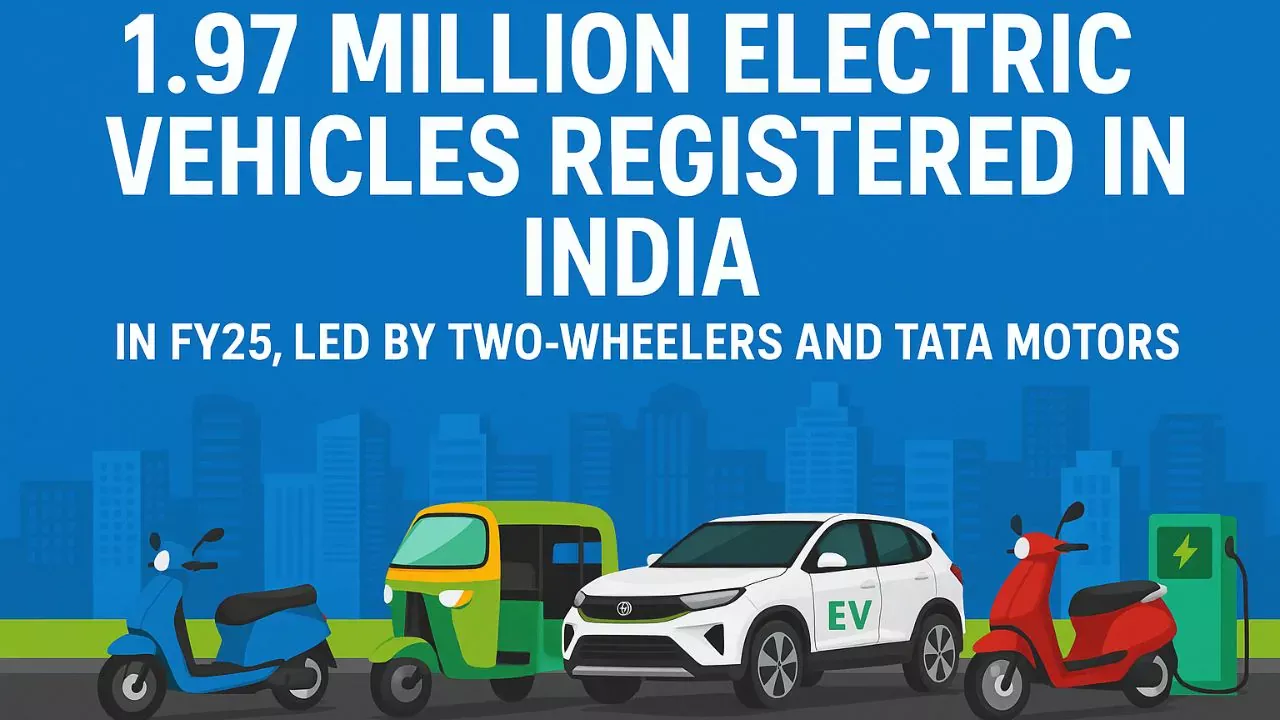India’s electric vehicle (EV) revolution is speeding up! In the financial year 2025 (FY25), a whopping 1.97 million electric vehicles were registered across the country, a 17% jump from the previous year. This surge is powered by the rising popularity of electric two-wheelers (e-2Ws) and three-wheelers (e-3Ws), with electric cars also gaining ground.
With Tata Motors leading the charge, followed by JSW MG Motor India, Hyundai, and Mahindra & Mahindra, India’s EV market is buzzing with excitement. Here’s everything you need to know about this electrifying trend.
Why Are EVs So Popular in India Now?
The massive growth in EV registrations shows that Indians are embracing greener, cleaner transport. Here’s what’s driving the boom:
Electric Two-Wheelers (e-2Ws) Take the Lead: Affordable and perfect for city commuting, electric scooters and bikes are the biggest contributors to the EV surge. Brands like Ola Electric, Ather Energy, and Bajaj Auto are winning hearts with stylish, budget-friendly models.
Three-Wheelers (e-3Ws) Shine: Electric rickshaws and cargo vehicles are a hit in urban and rural areas. They’re cheap to run, eco-friendly, and ideal for small businesses.
Passenger Vehicles Grow: Electric cars now make up nearly 3% of all car sales in India. Models like the Tata Nexon EV, MG ZS EV, and Hyundai Kona Electric are attracting buyers looking for sustainable options.
Tata Motors Rules the EV Market
When it comes to electric cars, Tata Motors is the undisputed king. The company’s affordable and reliable EVs, like the Nexon EV and Punch EV, have captured a huge share of the market. Close behind are:
JSW MG Motor India: Known for the MG ZS EV, this brand is popular for its premium yet affordable electric SUVs.
Hyundai: The Kona Electric and Ioniq 5 are gaining fans for their sleek design and long range.
Mahindra & Mahindra: With models like the XUV400 EV and upcoming launches, Mahindra is a strong contender.
These companies are making EVs more accessible, helping India move toward its goal of 30% electric car sales by 2030.
What’s Fueling the EV Surge?
Several factors are sparking this EV boom in India:
Government Support: Policies like the FAME-II scheme and state-level subsidies make EVs cheaper. For example, Delhi’s EV Policy 2.0 offers cash incentives and tax breaks for buyers.
Lower Running Costs: EVs cost less to run than petrol or diesel vehicles, saving money on fuel and maintenance.
More Charging Stations: Cities like Bengaluru, Mumbai, and Delhi are adding thousands of charging stations, making EV ownership easier.
Eco-Friendly Mindset: Young Indians are choosing EVs to reduce pollution and fight climate change.
Challenges Ahead for India’s EV Market
Despite the growth, there are hurdles to overcome:
- High Upfront Costs: EVs are still pricier than traditional vehicles, though subsidies help.
- Battery Concerns: Buyers worry about battery life and replacement costs.
- Charging Infrastructure: While urban areas have more chargers, rural areas need better coverage.
Experts believe that as technology improves and prices drop, these challenges will fade, paving the way for even more EV adoption.
What’s Next for India’s EV Revolution?
The 17% growth in EV registrations is just the beginning. With 1.97 million EVs on the road in FY25, India is on track to become a global EV powerhouse. The government is pushing for more local manufacturing, better batteries, and widespread charging networks. Companies like Tata Motors, Ola Electric, and Mahindra are investing heavily to launch new models and capture the growing demand.
Posts on X highlight the excitement, with users praising Tata’s leadership and calling for more affordable EVs. As India races toward a greener future, the EV market is set to soar even higher in the coming years.
Conclusion: India’s Electric Future Is Bright
India’s EV market is charging ahead, with 1.97 million vehicles registered in FY25 and a 17% growth rate. From zippy electric scooters to stylish electric SUVs, there’s an EV for every Indian. Tata Motors, JSW MG Motor, Hyundai, and Mahindra are leading the way, backed by government support and a growing network of chargers. If you’re thinking of going electric, now’s the perfect time to join the revolution!

